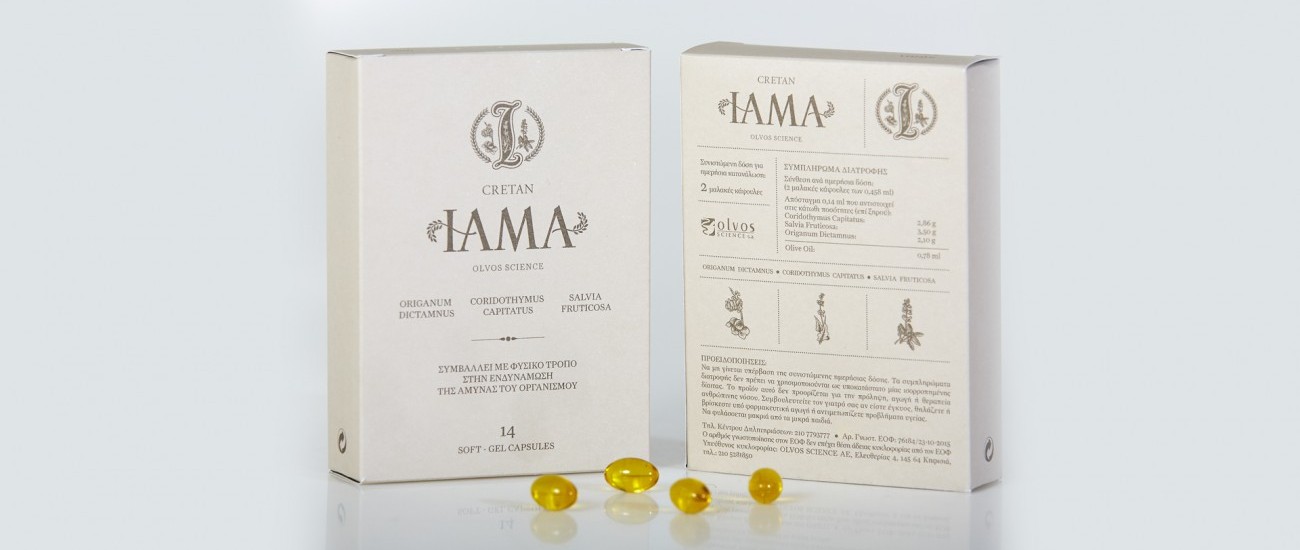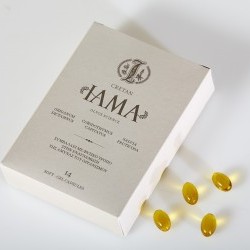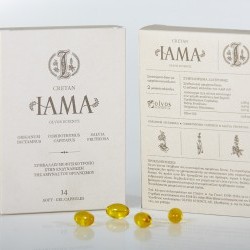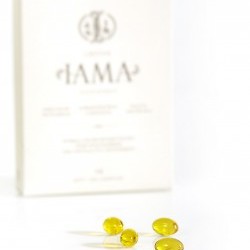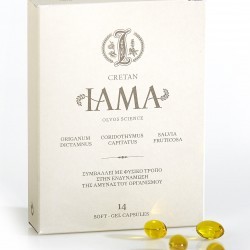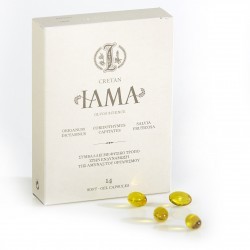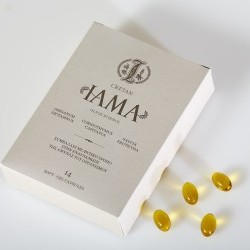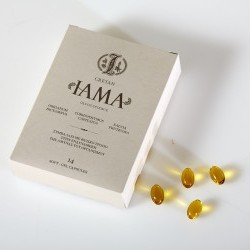Cretan IAMA OLVOS SCIENCE
Cretan IAMA OLVOS SCIENCE is the fruit of many years of research from distinguished professors of the University of Crete, who transformed indigenous knowledge to substantial knowledge, in cooperation with Οlvos Science company, a subsidiary of the Greek pharmaceutical company Galenica.
It contains essential oils of 3 aromatic herbs, Coridοthymus Capitatus (thyme), Salvia Fruticosa (sage) and Origanum Dictamnus (Cretan dittany), in specific proportions within extra virgin olive oil, naturally helping body’s defence strengthening.
Cretan IAMA OLVOS SCIENCE began, was studied, completed and produced entirely in Greece and it is registered as international patent. For its production, plant material authentication and homogeneity testing (DNA-Barcoding) is followed.
Cretan dittany or Dittany of Crete (Origanum dictamnus)
Endemic herb of Crete. From the very old times the healing properties of Cretan dittany are known, as well as the fact that Crete’s wild goats were eating Cretan dittany to heal their wounds when hurt by hunter’s arrows. In total, there are approximately 220 works of ancient Greek authors with more than 500 reports on Cretan dittany’s therapeutic use.
Sage (Salvia fruticosa)
The name Salvia comes from the Latin salvare meaning I save lives. It was considered as a sacred herb by the Greeks, who dedicated it to Zeus. Our ancestors used it as a multi-medicine and it is mentioned by Dioscorides, Aetios, Hippocrates and Galen, who praised it.
Thyme (Coridothymus capitatus)
Thyme is known since the ancient times. It was used by all initial Mediterranean civilisations as a pharmaceutical plant, while both Hippocrates and Dioscorides describe its uses in their writings. Before modern antibiotics, thyme was widely used for dressing and bandage impregnation.
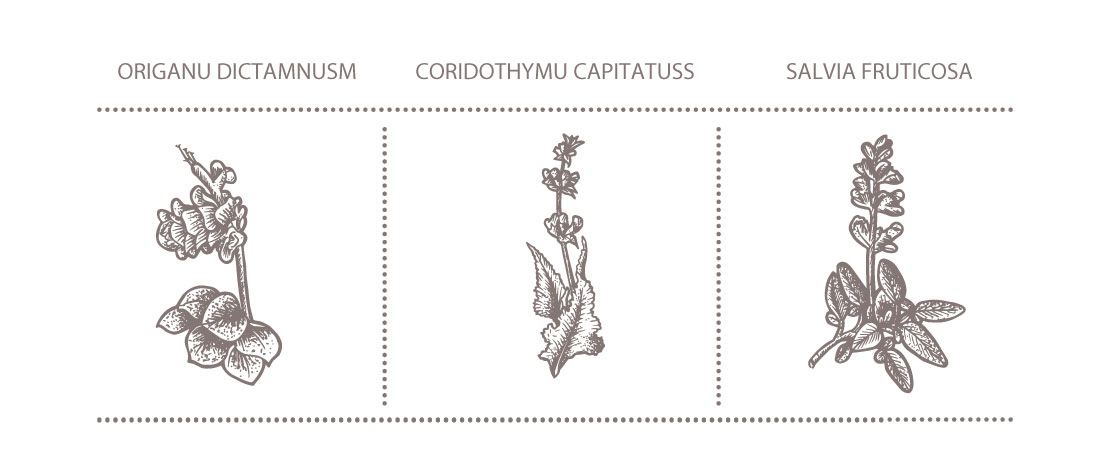
From indigenous knowledge to scientific data
The idea started a few years ago, when epidemiological observations in regions of Crete showed that people who were drinking certain herbal infusions had much lower morbidity and lower impact from cold or flu. The study of researchers from the University of Crete was published in the prestigious international biomedical journal Lancet. Aromatic herbs success was then attributed to their antioxidant properties (Lionis C. et al. Antioxidant effects of herbs in Crete. Lancet 1998, Vol. 352).
What was highlighted by indigenous knowledge regarding the beneficial effect of certain aromatic herbs in upper respiratory infections led researchers to the next step. After many years of tests, research revealed a combination of essential oils of 3 aromatic herbs, Coridοthymus Capitatus, Salvia Fruticosa and Origanum Dictamnus, in specific proportions, which works synergistically.
Then a study on 105 patients with upper respiratory viral infection was conducted, with beneficial results (G. Duijker, A. Bertsias, E. Symvoulakis, J. Moschandreas, N.Malliaraki C, S.P. Derdas, S.A. Pirintsos, G. Sourvinos, E. Castanas, C. Lionis. Reporting effectiveness of an extract of three Cretan herbs on upper respiratory tract infection: results from a double-blind randomized controlled trial. Journal of Ethnopharmacology 2015, Vol. 163)
Recommended for daily use dose
2 soft capsules
Warnings
The recommended daily dose should not be exceeded.
Food supplements should not be used as a substitute for a balanced diet. Consult your doctor during pregnancy, breastfeeding, and if you receive any medication or have any health problems. Keep away from children.
Poison Centre Tel.: 210 779377
Crete, a land untouched by time
Crete is flora’s crossroad in Eastern Mediterranean Sea. Its flora has not changed significantly over time, mainly thanks to its morphology. The island’s climate contributes in the development of rich flora, with different ecosystems, composing a set of rare diversity. There is probably no other area in the earth with similar size like Crete and so many plant types.
Endemic plants richness is due to the many years of Crete’s isolation from the mainland, the presence of high mountains and the great variety of habitats, which became shelters of endemic, rare and endangered plant species, extinct from other areas.
Aromatic herbs are a great tradition for Crete, and they are known for their pharmaceutical properties from the ancient times.
Crete was an export centre of pharmaceutical and aromatic herbs. Actually, it is characteristic that approximately 15% of 13th century BC Linear B plates discovered in Knossos concern perfumes and aromatic plants.
Greek land perfumes
Greek flora is one of the richest in the Mediterranean. Greece has 6% of the Mediterranean area, but 26% of Mediterranean flora. Greece’s great biological wealth is mainly due to its geographical position, its topographic diversity, its composite geological and ecological history, and the relatively mild human interventions.
In recent years there is increasing interest for Greek aromatic plants with tens of uses. Today, both Greek and international industry use aromatic plants for the production of cosmetics, drugs and medicines.
In each aromatic plant there are hundreds of different chemical elements. The combinations of different plants and herbs can benefit the body through synergies created by each plant’s therapeutic substances.
Through history
In Greece, the use of aromatic plants has its roots in ancient times. Ancient Greek authors’ knowledge of the therapeutic use of various plant species has been maintained in the passage of time, and today they constitute to a great extent the foundation of contemporary folk healing.
Although we have references for herbs healing properties from the time of Homer, it was Hippocrates and Dioscorides who laid modern medicine’s foundations.
Hippocrates, the father of Medicine introduced observation and experimentation in therapeutic practice, and recorded about 400 herb species with known uses during the 5th century BC.
Theophrastus is known as the “Father of Botany”, with written references about morphology, growth and activity of drugs (On the History of Plants, On the Causes of Plants), which are preserved until today.
Dioscorides was the most famous specialist in medicines, with not only approximately 600 herbs and their properties being mentioned in his work, but also their herbal characteristics, which are being described in detail. Other persons of particular importance in the progress of Medicine - Pharmacy (for many more years there was no clear distinction between the two sciences) followed, such as Galen.
